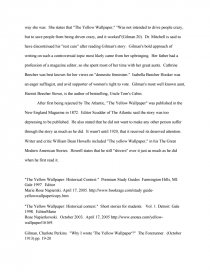The Yellow Wallpaper
Essay by review • January 23, 2011 • Essay • 677 Words (3 Pages) • 1,094 Views
The plot of "The Yellow Wallpaper" comes from a moderation of Charlotte Perkins Gilman's personal experience. In 1887, just two years after the birth of her first child, Dr. Silas Weir Mitchell diagnosed Gilman with neurasthenia, an emotional disorder characterized by fatigue and depression. Mitchell decided that the best prescription would be a "rest cure". Mitchell encouraged Gilman to "Live a domestic life as far as possible," to "have two hours' intellectual life each day," and to "never touch a pen, brush or pencil again,"(Gilman 20) as long as she lived. After three months of isolation, abiding by Dr. Mitchell's orders, Gilman realized she was becoming insane. She abandoned Dr. Mitchell's advice and, after recovering, she wrote an exaggerated version of her experience.
Written in 1892, "The Yellow Wallpaper" reflects the social mindset of United States' citizens just after the Civil War. This was a time of cultural and economical growth, expansion, and development. Women received little political and social freedom; their actions were greatly influenced by their husbands' wills. The wallpaper's chaotic pattern represents the metaphorical bars that Jane feels trapped in as a woman. The woman in the paper represents Jane trying to escape and become free from the reigns of her husband. Women were not expected to have a career or a "public life;" instead, they were expected to focus on the upkeep of home and family. People in this time lived with the mindset that women were nice to look at, and were to be seen, not heard. With this story, Gilman brought into light that women have the capacity to think for themselves and the right to express these thoughts. "The Yellow Wallpaper" depicts this by showing that Gilman manages to overcome the constraints of her husband and the doctor in order to be able to write and to become free.
Gilman's purpose for writing "The Yellow Wallpaper," was to make Dr. Mitchell's bogus cure known. She wanted to make sure no other woman was diagnosed and treated in the same way she was. She states that "The Yellow Wallpaper," "Was not intended to drive people crazy, but to save people from being driven crazy, and it worked"(Gilman 20). Dr. Mitchell is said to have discontinued his "rest cure" after reading Gilman's story. Gilman's bold approach of writing on such a controversial topic most likely came from her upbringing. Her father had a profession of a magazine editor, so she spent most of her time with her great aunts. Cathrine Beecher was best known for her views on "domestic feminism." Isabella Beecher Hooker
...
...


